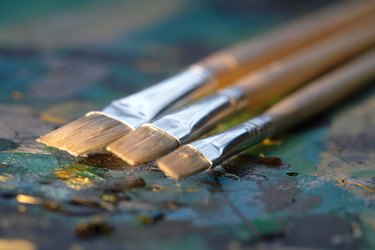Things You'll Need
Palette or plate
Small paint brushes
Paper towels
Blue acrylic paint
Green acrylic paint
Yellow acrylic paint
White acrylic paint
Aquamarine blue acrylic paint

Mixing acrylic paints is both an enjoyable and beneficial part of the painting process for intermediate and professional artists alike. It allows artists to create a specific shade, such as cyan, using at least two different colors of paint. Cyan is green-blue, which makes it a complement of red, meaning that cyan pigments absorb red light. An artist who mixes acrylic paint colors needs only a few shades of paint, which most often contain at least the three primary colors: blue, red and yellow which, when mixed together evenly, create black.
Mixing Green and Blue
Step 1
Clean your paint palette or plate or use a new one. It should not have any remaining paint on it. Then, clean your paintbrushes thoroughly using running water. With your fingers, rub the bristles of each brush to remove any dry paint. Wipe the brushes and the palette or plate dry with a paper towel.
Video of the Day
Step 2
Squeeze out small, even amounts of blue and green acrylic paint onto your palette. Green and blue light are mixed together to form cyan light, but when it comes to paint, you will end up getting a dark color, which needs to be lightened.
Step 3
Mix the paint together using a small paintbrush until it looks evenly mixed. Depending on the shade of your paint, considering that there are many different shades of blue and green paint, add either yellow or white acrylic paint to the mix. To determine this, separate the mixed green and blue paint dollop in half.
Step 4
Add yellow paint to one of the green and blue paint dollops and mix using your paintbrush. Add more yellow paint if the color is close to cyan, and mix evenly.
Step 5
Add white paint to the second dollop and mix. Keep on adding white paint until you achieve a cyan shade you are satisfied with. You may add more green or blue paint if the shade is too light.
Step 6
Compare the two shades and stick to the one that is closest to cyan. Cyan is a secondary color, which is hard to mix using acrylic paints, but one of your paint colors now should be close to cyan.
Step 7
Make a note either mental or on paper as to how much of each color you used to achieve the ideal cyan shade and get ready to start painting.
Using Aquamarine Blue
Step 1

Squeeze out aquamarine blue paint onto a clean palette or plate. Aquamarine blue is a blue-green shade that closely resembles cyan.
Step 2
Add a tiny bit of white paint to the aquamarine paint.
Step 3
Mix the paint evenly using a clean paintbrush. Add more white paint if necessary.
Tip
Start with small amounts of each paint color to avoid wasting paint when mixing cyan for the first time.
Video of the Day